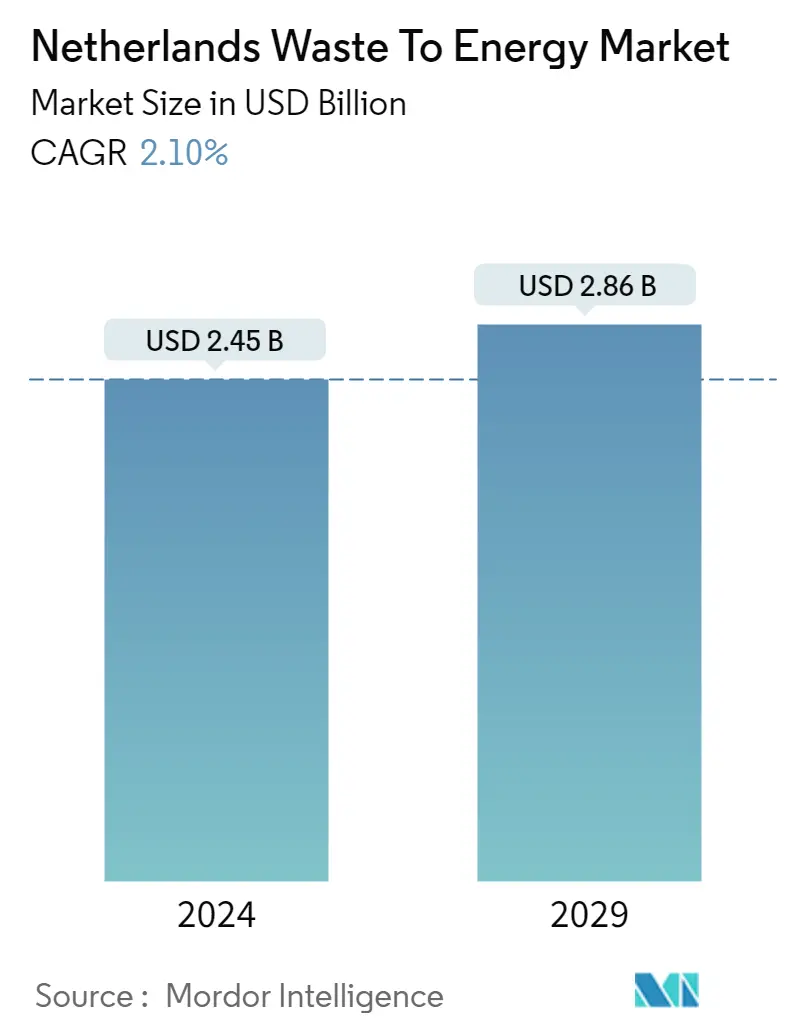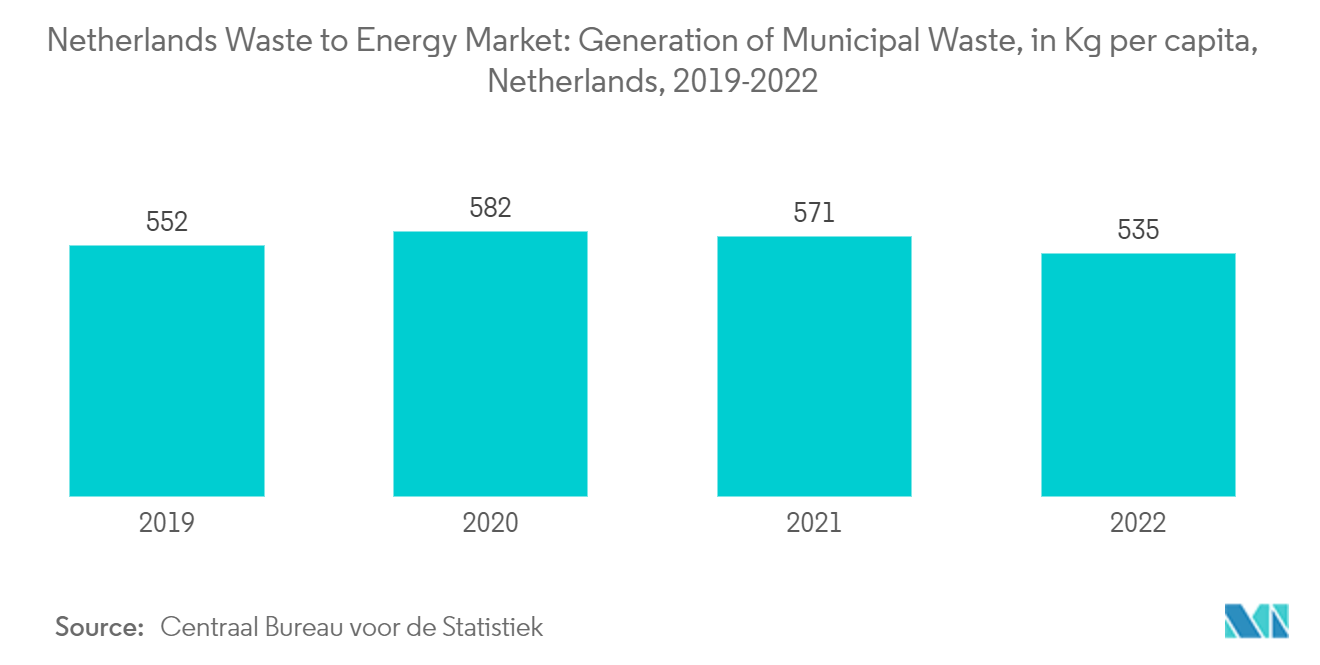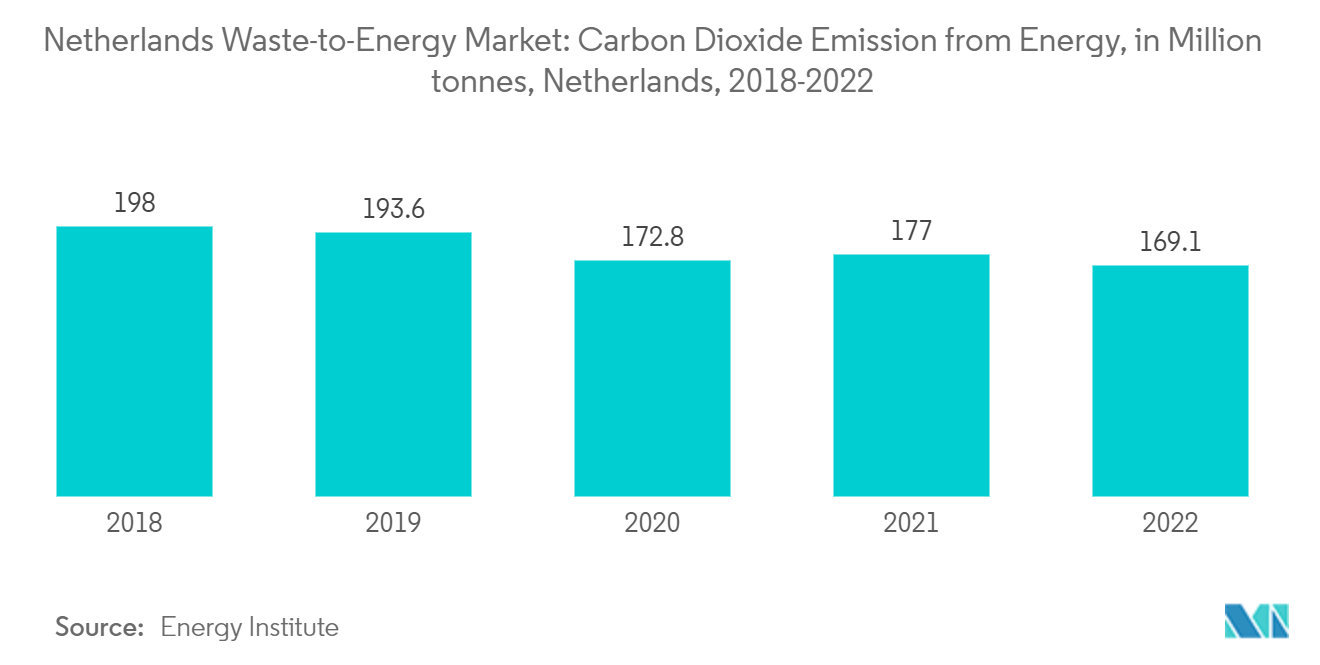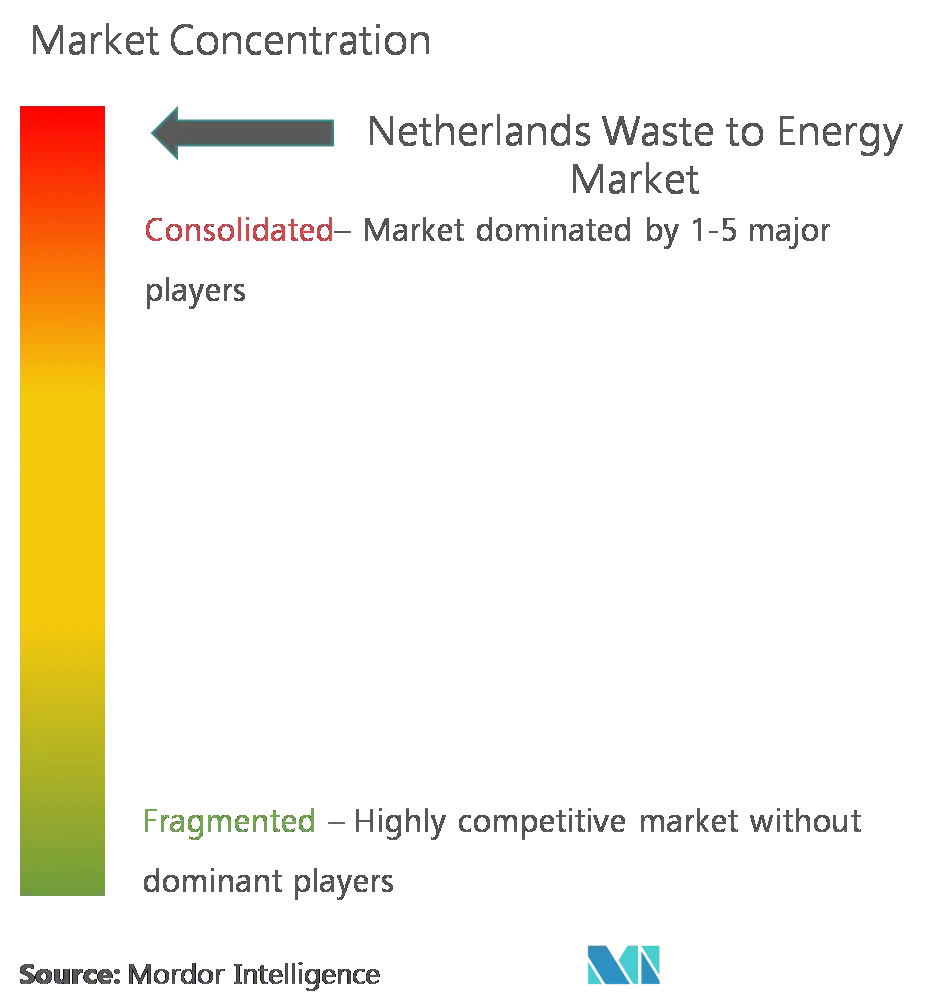Netherlands Waste to Energy Market Size

| Study Period | 2020 - 2029 |
| Base Year For Estimation | 2023 |
| Market Size (2024) | USD 2.45 Billion |
| Market Size (2029) | USD 2.86 Billion |
| CAGR (2024 - 2029) | 2.10 % |
| Market Concentration | High |
Major Players
*Disclaimer: Major Players sorted in no particular order |
Netherlands Waste to Energy Market Analysis
The Netherlands Waste To Energy Market size is estimated at USD 2.45 billion in 2024, and is expected to reach USD 2.86 billion by 2029, growing at a CAGR of 2.10% during the forecast period (2024-2029).
- Over the medium term, factors such as supportive government policies and increased investments in waste-to-energy industries are expected to drive of the Netherlands waste-to-energy market during the forecast period.
- On the other hand, the strict regulation imposed against the release of harmful gases when trash is burned is likely to hamper the waste-to-energy market in the Netherlands.
- Nevertheless, the Dutch government wants to get rid of all carbon emissions by 2050. This is likely to encourage the use and installation of renewable energy sources. This is likely to open up a lot of opportunities for the waste-to-energy market in the Netherlands during the forecast period.
Netherlands Waste to Energy Market Trends
Thermal Technologies Segment to Dominate the Market
- The Netherlands is small in area but significant in agricultural output. It is second only to the United States in the value of its agricultural work. As of 2022, it had 17.5 million people, which generated about 535 kg of waste per capita.
- In the Netherlands, waste-to-energy plants incinerate residual household and similar waste that cannot be reused or recycled, which is economically and environmentally beneficial. They are cost-effective and reliable energy sources for electricity, district heating or cooling, and industrial processes. The heat and electricity delivered to housing and industry reduce the use of fossil fuels in conventional power plants. Waste-to-energy plants, therefore, help to reduce CO2 emissions.
- The Netherlands needs more landfill capacity and thermal treatment capacity. This has urged a change in waste management policy, with the following results: The amount of waste landfill decreased from 35% in 1985 to less than 2% in 2018. The recovery rate (including waste-to-energy) rose from 50% to 93%, and more and more waste was collected separately. As of 2022, nearly 80% of the country's waste is recycled, and residual waste is mainly used for energy production.
- It is estimated that plants that utilize thermal power cogeneration (heating and cooling) and electricity generation can reach optimum efficiencies of 80%. In the present scenario, incineration is the most well-known waste-to-energy technology for municipal solid waste (MSW) processing. However, waste-to-energy technologies, particularly combustion, produce pollution and carry potential health and safety risks.
- Therefore, due to the above points, the thermal technology segment is expected to dominate the Dutch waste-to-energy market during the forecast period.

Government Policies and Increasing Investments Driving the Market Demand
- It took the Netherlands about 40 years to get their waste per person down from an estimated 500 kilograms to a relatively low 21 kilograms in some areas. It results from many government policies and methods for handling municipal trash.
- By 2050, the Dutch government aims to have a circular economy. The government has developed several initiatives to attract investments in the waste-to-energy sector to increase the overall recycling rate.
- Most waste is processed differently, such as through recycling and composting waste and combustion for power generation. The Netherlands is famous for having one of Europe's highest recycling rates of all material waste, at about 79% yearly. As of 2022, nearly 80% of municipal waste was recycled in the country. The residual waste was mainly used for energy production through 13 waste incinerators in the Netherlands.
- The SDE++ 2021 round was held in the Netherlands in 2021, and it cost 5 billion euros to do so.SDE++ stands for sustainable energy production and climate transition. It is a subsidy scheme introduced for renewable energy producers and also for CO2 reduction techniques that are available for waste-to-energy market players.
- Furthermore, the Dutch government charges a landfill tax, which is aimed at helping achieve the shift toward less landfilling and more recovery and recycling of waste. The increasing use of waste-to-energy processes burns waste to produce heat or electricity. This reduced the greenhouse gas emissions in the environment. In 2022, nearly 169.1 million tons of carbon dioxide emission will be generated from energy, decreasing from 177 million tons in 2021.
- Hence, due to the above points, supportive government policies and increasing investments in the country are expected to drive the Netherlands' waste-to-energy market during the forecast period.

Netherlands Waste to Energy Industry Overview
The Netherlands' waste-to-energy market is consolidated. Some major players (in no particular order) include AEB Bio-energie centrale BV, Axpo Holdings AG, Dutch Incinerators BV, Indaver BV, and Attero BV.
Netherlands Waste to Energy Market Leaders
-
AEB Bio-energiecentrale B.V.
-
Axpo Holdings AG
-
Dutch Incinerators B.V.
-
Indaver BV
-
Attero BV
*Disclaimer: Major Players sorted in no particular order

Netherlands Waste to Energy Market News
- January 2023: RWE received USD 117 million from the European Union's Innovation Fund to help build a waste-to-hydrogen project in an industrial cluster in the Netherlands.
- May 2022: At Twence's waste-to-energy plant in Hengelo, Netherlands, Aker Carbon Capture began building its Just Catch modular carbon capture plant. As a result of the plant, CO2 emissions were to be reduced and associated with the incineration of non-recyclable waste to generate energy. A standardized Just Catch plant is expected to begin capturing 100,000 metric tons of CO2 per year by the end of 2023; this captured carbon will then be used as liquid fertilizer for greenhouse horticulture operations.
Netherlands Waste to Energy Market Report - Table of Contents
1. INTRODUCTION
- 1.1 Scope of the Study
- 1.2 Market Definition
- 1.3 Study Assumptions
2. RESEARCH METHODOLOGY
3. EXECUTIVE SUMMARY
4. MARKET OVERVIEW
- 4.1 Introduction
- 4.2 Installed Capacity and Forecast, till 2028
- 4.3 Recent Trends and Developments
- 4.4 Government Policies and Regulations
-
4.5 Market Dynamics
- 4.5.1 Drivers
- 4.5.1.1 Supportive Government Policies for Waste-to-Energy Plants
- 4.5.1.2 Increasing Investments in Waste-to-Energy Industries
- 4.5.2 Restraints
- 4.5.2.1 The Strict Regulation Imposed Against the Release of Harmful Gases When Trash is Burned
- 4.6 Supply Chain Analysis
- 4.7 PESTLE Analysis
5. MARKET SEGMENTATION BY TECHNOLOGY
- 5.1 Thermal Technologies
- 5.2 Non-Thermal Technologies
6. COMPETITIVE LANDSCAPE
- 6.1 Mergers and Acquisitions, Joint Ventures, Collaborations, and Agreements
- 6.2 Strategies Adopted by Leading Players
-
6.3 Company Profiles
- 6.3.1 AEB Bio-energiecentrale BV
- 6.3.2 Axpo Holdings AG
- 6.3.3 Ingenia Consultants & Engineers BV
- 6.3.4 Dutch Incinerators BV
- 6.3.5 Indaver BV
- 6.3.6 Attero BV
- 6.3.7 AEB Amsterdam
- 6.3.8 Mitsubishi Heavy Industries Ltd.
- *List Not Exhaustive
7. MARKET OPPORTUNITIES AND FUTURE TRENDS
- 7.1 The Government Wants to Become Carbon Emissions Free by 2050 Which will Encourage the Installation of Renewable Energy Sources
Netherlands Waste to Energy Industry Segmentation
The waste-to-energy process generates electricity and/or heat from the process of treating waste as fuel or turning waste into a fuel source.
The Netherlands waste-to-energy market report is segmented by technology type. By technology type, the market is segmented into into thermal technologies and non-thermal technologies. The market sizing and forecasts for each segment are based on installed capacity.
Netherlands Waste to Energy Market Research FAQs
How big is the Netherlands Waste To Energy Market?
The Netherlands Waste To Energy Market size is expected to reach USD 2.45 billion in 2024 and grow at a CAGR of 2.10% to reach USD 2.86 billion by 2029.
What is the current Netherlands Waste To Energy Market size?
In 2024, the Netherlands Waste To Energy Market size is expected to reach USD 2.45 billion.
Who are the key players in Netherlands Waste To Energy Market?
AEB Bio-energiecentrale B.V., Axpo Holdings AG, Dutch Incinerators B.V., Indaver BV and Attero BV are the major companies operating in the Netherlands Waste To Energy Market.
Waste to Energy in Netherlands Industry Report
Statistics for the 2024 Netherlands Waste To Energy market share, size and revenue growth rate, created by Mordor Intelligence™ Industry Reports. Netherlands Waste To Energy analysis includes a market forecast outlook to for 2024 to 2029 and historical overview. Get a sample of this industry analysis as a free report PDF download.



